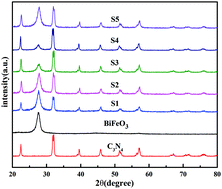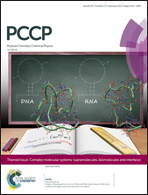Enhanced photocatalytic efficiency of C3N4/BiFeO3 heterojunctions: the synergistic effects of band alignment and ferroelectricity†
Abstract
As one of the most promising photocatalysts, graphitic carbon nitride (g-C3N4) shows a visible light response and great chemical stability. However, its relatively low photocatalytic efficiency is a major obstacle to actual applications. Here an effective and feasible method to dramatically increase the visible light photocatalytic efficiency by forming C3N4/BiFeO3 ferroelectric heterojunctions is reported, wherein the band alignment and piezo-/ferroelectricity have synergistic positive effects in accelerating the separation of the photogenerated carriers. At the optimum composition of 10 wt% BiFeO3, the heterojunction shows 1.4 times improved photocatalytic efficiency than that of the pure C3N4. Most importantly, mechanical pressing and electrical poling can also improve the photocatalytic efficiencies by 1.3 times and 1.8 times, respectively. The optimized photocatalytic efficiency is even comparable with that of some noble metal based compounds. These results not only prove the improved photocatalytic activity of the C3N4–ferroelectric heterojunctions, but also provide a new approach for designing high-performance photocatalysts by taking advantage of ferroelectricity.



 Please wait while we load your content...
Please wait while we load your content...